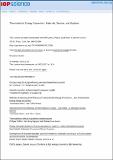Thermoelectric Energy Conversion: Materials, Devices, and Systems
Author(s)
Chen, Gang
DownloadChen_Thermoelectric energy.pdf (949.6Kb)
PUBLISHER_CC
Publisher with Creative Commons License
Creative Commons Attribution
Terms of use
Metadata
Show full item recordAbstract
This paper will present a discussion of challenges, progresses, and opportunities in thermoelectric energy conversion technology. We will start with an introduction to thermoelectric technology, followed by discussing advances in thermoelectric materials, devices, and systems. Thermoelectric energy conversion exploits the Seebeck effect to convert thermal energy into electricity, or the Peltier effect for heat pumping applications. Thermoelectric devices are scalable, capable of generating power from nano Watts to mega Watts. One key issue is to improve materials thermoelectric figure- of-merit that is linearly proportional to the Seebeck coefficient, the square of the electrical conductivity, and inversely proportional to the thermal conductivity. Improving the figure-of-merit requires good understanding of electron and phonon transport as their properties are often contradictory in trends. Over the past decade, excellent progresses have been made in the understanding of electron and phonon transport in thermoelectric materials, and in improving existing and identify new materials, especially by exploring nanoscale size effects. Taking materials to real world applications, however, faces more challenges in terms of materials stability, device fabrication, thermal management and system design. Progresses and lessons learnt from our effort in fabricating thermoelectric devices will be discussed. We have demonstrated device thermal-to-electrical energy conversion efficiency ~10% and solar-thermoelectric generator efficiency at 4.6% without optical concentration of sunlight (Figure 1) and ~8-9% efficiency with optical concentration. Great opportunities exist in advancing materials as well as in using existing materials for energy efficiency improvements and renewable energy utilization, as well as mobile applications.
Date issued
2015-12Department
Massachusetts Institute of Technology. Department of Mechanical EngineeringJournal
Journal of Physics: Conference Series
Publisher
IOP Publishing
Citation
Chen, Gang. “Thermoelectric Energy Conversion: Materials, Devices, and Systems.” Journal of Physics: Conference Series 660 (December 10, 2015): 012066.
Version: Final published version
ISSN
1742-6588
1742-6596